
|
|
10 November, 1999
The weather turned again in McMurdo. Low visibility and high winds. I spent
much of the day in the lab processing samples. They keep coming in from the
drill site. The most recent rocks drilled have been primarily clean coarse
sandstones. The loose nature of the sandstones has caused some problems with
the drilling. Also, the hard quartz grains are hard on the drill bits. These
sandstones do not contain a lot of fossils. Active environments, like the
ones that deposited these rocks, are not conducive to fossil formation. This
dearth of fossils has made it difficult for the paleontologists to determine
the age of the rocks. They know they were in rocks of the Oligocene Epoch
(about 30 million years old). They are hoping to find rocks of the Eocene
epoch (about 34 million year old) so they can explore the conditions in
Antarctica at that time. They are unsure exactly the age of the rocks they
are in. They have recently brought up a piece of fossil wood, but this has
not given them any additional age information yet. They continue to drill.
I paid a visit to "Ground Station Antarctica" the other day. This is a NASA
facility that tracks polar orbiting satellites and downloads data from them.
Antarcticas' location near the South Pole makes it an ideal location for
tracking polar orbiting satellites. There is a similar facility at Poker
Flat Research Range near Fairbanks, Alaska. Polar orbiters are in an orbit
that passes over each pole. As the earth rotates under the satellite with
each orbit a different swath of the Earth can be viewed by the satellite.
This makes polar orbiting satellites ideal for mapping and other Earth
monitoring missions. The Antarctic Ground Station also supplies support for
NASA launch missions by tracking the rocket during and after launch. The
facility is composed of a control room located in Crary Science and
Engineering Center at McMurdo and a 10 meter dish antenna. The antenna is
housed in a large, white fabric dome perched up on a ridge above McMurdo.
The dome is a very prominent landmark from town. When I stopped by the
control room, which is located across the hall from the lab I work in, Chuck
Seman and Jamie Gallo were in the process of locking on to a TRACE satellite
in preparation to downloading the data. The dish antenna is aimed by remote
control at the satellite and at a pre-determined time, the data from the
"bird" is downloaded to the ground station. The reason this is necessary is
that the memory storage capability of the satellite is limited and the data
must be continually removed. The data is transmitted to Goddard Space Flight
Center in Greenbelt, Maryland for processing. The TRACE satellite is used to
study the photosphere of the sun. The photosphere is where the magnetic
fields of the sun interact with plasma to produce flares, prominences and
sunspots. If you want to find out more about TRACE, check out this web site:
http://vestige.lmsal.com/TRACE/. You will find some spectacular images of
the sun. I also got a chance to see the 10-meter dish. The site also gives
you a great view of Mactown and Mt. Erebus.
Today's featured CRP Team Members are two members of the Italian contingent
of the Cape Roberts Project. They are Massimo Sarti, a sedimentologist from
the University of Ancona, and Marco Taviani, a paleontologist from the
National Research Council in Bologna. Massimo works on describing the
sediment structures and deposition environment of the core samples along
with the other sedimentologists. Marco examines and identifies the
macro-fossils found such as mussels, snails and clams.
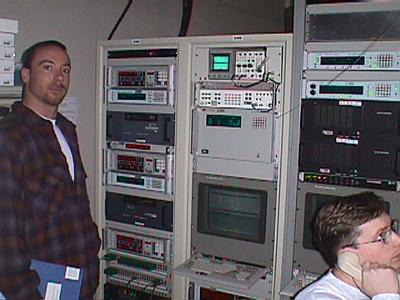
Part of the many computer and receivers at Ground Station Antarctica.
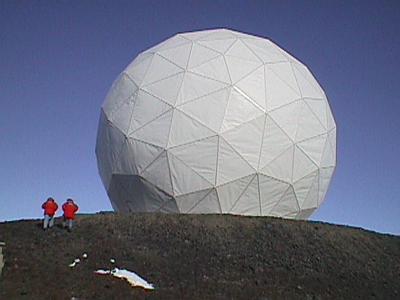
The Radome housing the satellite receiving antenna.
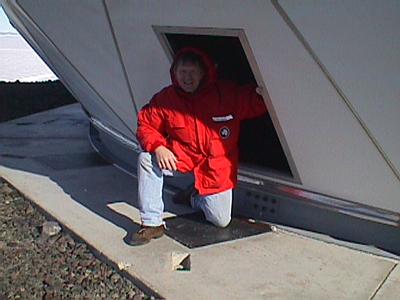
I got a chance to go inside the Radome and view the dish.
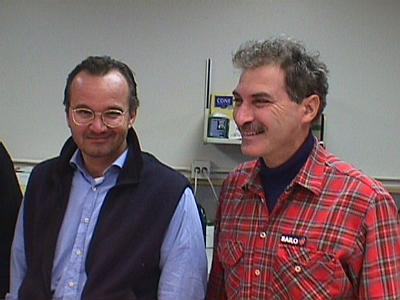
Massimo Sarti, left, and Marco Taviani. "Due baldi geologi!"
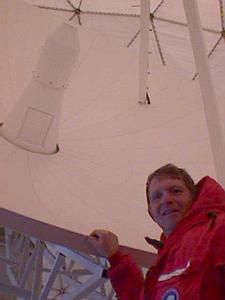
The 10-meter dish inside the Radome.
Contact the TEA in the field at
.
If you cannot connect through your browser, copy the
TEA's e-mail address in the "To:" line of
your favorite e-mail package.
|
